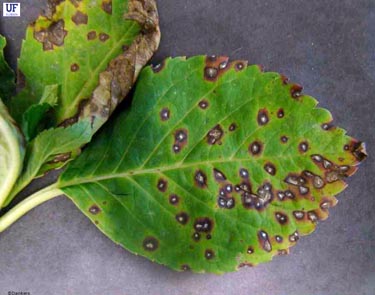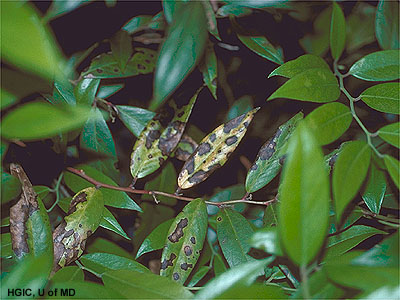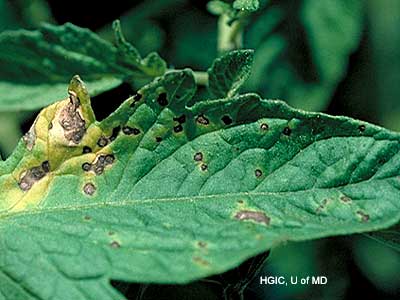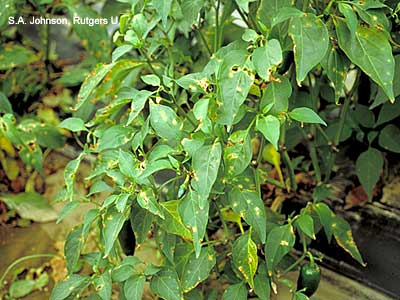Leaf Spot Diseases of Ornamentals, Shade Trees, Vegetables
By Pat Dickey, Fairfax Master Gardener

Cercospora on hydrangea
Leaf spots vary, depending on the plant that has the disease and the organism that transmitted it. They can have a black, tan, purple or red color, and black concentric rings or margins around them. Fungal black dots may appear in the spots, in rings or in a cluster. Over time, these may enlarge and combine to form blotches. Some of the infected plant’s leaves may turn yellow and drop.
Environmental and Cultural Factors
Fungal pathogens for leaf spot disease are in the air and soil. They continue to live in infected leaves and twigs that have fallen to the ground. When it rains and the humidity is high, the water causes the spores in the infected leaves to grow into a fungus. These fungal spores then scatter in the wind and settle on new, emerging plant growth. The spores germinate there and infect the tender leaves.
Close spacing of plants can result in leaf spot diseases. Moisture builds up and leaves will stay wet, with air unable to circulate. Overhead irrigation, especially late in the day and at night, also contributes to these diseases, since the wet leaves do not have an opportunity to dry out, and fungal leaf spot can take hold, especially on vegetables.
Shrubs and Shade Trees

Fungal leaf spot on Leucothoe
Repeated spraying of fungicides on shrubs and shade trees will not cure leaf spot disease and is not recommended. Fungicides are designed to be protective and must be applied before the fungus is on the plant’s surface. It is also impractical to spray fungicides on mature shade trees because of their size and the cost involved. Many older trees develop leaf diseases from the stresses of old age. Be concerned only if the tree defoliates repeatedly over many years and does not recover. Most shrubs and shade trees are tolerant of possible defoliation from leaf spot because it usually occurs at the end of the season.
If established shrubs show signs of leaf spot disease, prune and rake up any infected leaves and dead twigs in the dry, summer months and bag them in your trash. This will help keep the disease from spreading. Also prune to thin your shrubs, allowing air to better circulate. Avoid any overfertilization and water your plants at the roots, not from overhead. Use just 2 inches of shredded bark for mulching around your shrubs and trees. If you decide to replace your shrubs, ask your nursery about selecting resistant varieties.
Vegetables

Septoria on tomatoes
Bacterial leaf spot (Xanthomonas), which infects peppers and occasionally tomatoes, can affect the entire plant as well as the leaves. It can be brought into your garden from infested seeds and diseased transplants. Small pimple-like lesions will appear on the lower side of older leaves. The upper side of the leaves will have small water-soaked spots that develop gray to tan centers with dark borders. These lesions will become larger in warm, humid and wet weather and may also form on stems. Fruits may also have small raised, rough spots, and plants may completely defoliate.

Bacterial leaf spot on pepper
References
Leaf Spot Diseases of Shade Trees and Ornamentals, Missouri Botanical Garden
Fungal Leaf Spots – Shrubs, Home and Garden Information Center, University of Maryland Extension
Leaf Spots, Center for Urban Agriculture, University of Georgia Extension
Cercospora Leaf Spot – Vegetables, University of Maryland Extension
Bacterial Leaf Spot of Pepper – Vegetables, University of Maryland Extension
Septoria Leaf Spot on Tomato, Department of Plant Pathology, Physiology, and Weed Science, Virginia Tech